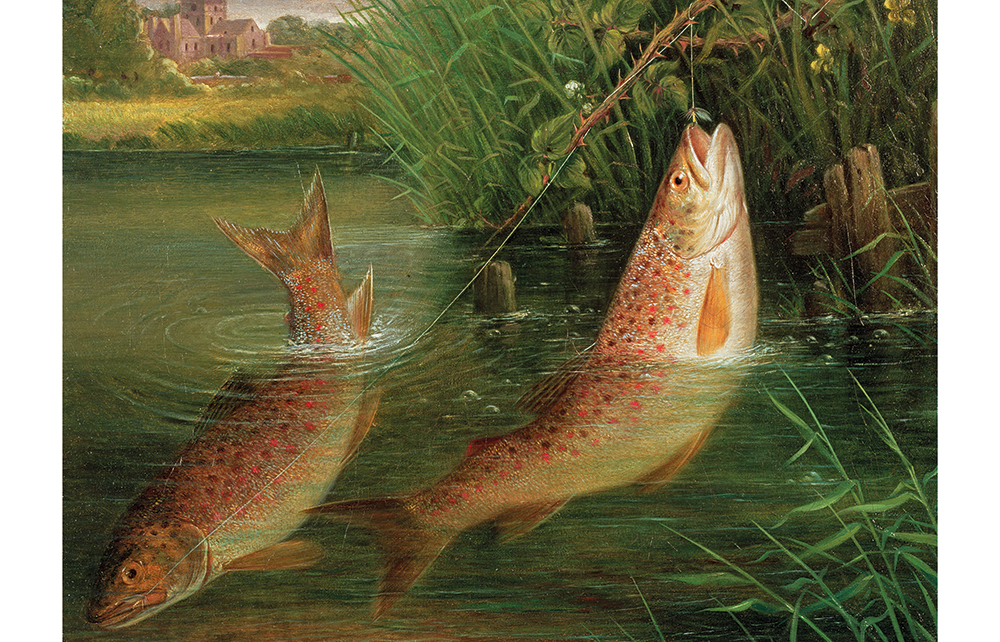Despite its many centuries of popularity – enthusiasts have ranged from Cleopatra to Eric Clapton – angling has been the subject of precious little historical scholarship, giving rise instead to anecdotalists or grim technicians. So Chris McCully’s latest animated and vigorous addition to the Bibliotheca piscatoria arrives as fresh and welcome as a run of summer salmon from the estuary.
The lexicon of angling, he suggests, can encode cultural histories – and so it does. The result is a stargazy pie of a book rich in natural lore and quirks, assembled with etymological rigour and finished with crisp wit. Drawn from diverse literary, ichthyological and halieutic sources – I ought to refrain from saying that McCully has cast his net wide – it spans Aelfric’s Colloquy and modern electronic resources, and runs from ‘adipose fin’ (that heraldic appendage of certain salmonids) to ‘zed’ (a nickname for the zander, misleadingly called the pike-perch, though it is no hybrid). As a fishing aficionado of some 60 years, I found it erudite and intriguing.
A few of the attestations are arresting: McCully cites Chaucer on bream and Dorothy Wordsworth’s journal for ‘pike float’. Some associated terms have leached into mainstream English – ‘loggerhead’, an appellation for the chub, owes nothing to trees; ‘logger’ is an old term for ‘clumsy’ – whereas others are falsely derived. The derogatory ‘old trout’ is not truttaceous, but stems from the Anglo-Norman ‘trot’, meaning a hag. Like the pastime itself, and Izaak Walton’s classic, it is full of curiosities, yet nicely prinked with orismology. So if you want to know how to tell a loach from a gudgeon (the former sports six whiskery barbules) or where to obtain isinglass (from the dried swim bladder of a sturgeon) or how the guppy got its name (from the Trinidadian naturalist R.J. Lechmere Guppy), then enquire within.
The term ‘old trout’ has nothing to do with fish but comes from the Anglo-Norman ‘trot’, meaning ‘hag’
Before we even arrive at regional and dialectal variations, some of the Linnaean designations are striking enough. The thin-lipped mullet enjoys the moniker Liza ramada, which sounds like a character from a Carl Hiaasen novel. And I am much taken with Phoxinus phoxinus for the minnow (sharing our author’s fondness for tiddlers, silverfish and ‘pinkeens’). Many of the folk names are colourful too: the bullhead is known as ‘miller’s thumb’ for its spatulate head; and the unlovely, rough little ruffe was once known by anti-Catholics as a ‘pope’. There is some tradition for naming fish after weapons: the dace was a ‘dart’, and the spike-jawed pike seems spear-like – though I prefer Esox Lucius (or ‘luce’) to be defined as a streak of subsurface light.
The anadromous sea-trout is ‘probably the most lexically endowed fish on the planet’, and McCully has bagged some 70 terms for it, including Candlemas grey, harvest-cock and whitling.
Thanks to that High Victorian predilection for categorising things, an unhelpful distinction persists between ‘coarse’ and ‘game’ species, supposedly based on their table qualities. But here all categories are treated with equal attention, and some fish are discussed in splendid, joyous little essays. Carp include ghosties, mirrors and the modern F1 hybrids; the digression on salmon starts with Bede and is a model of conciseness; trout begin their lexical life as Anglo-Saxon sceōte (signifying to ‘shoot’, or scoot), and only a chance French borrowing gave us truite. In Ireland’s Lough Melvin alone there coexist three separate strains – ferox, gillaroo and sonaghan. It’s a lively line-up.
In the verbal byways we encounter regrettably obsolete terms (‘shaftling’ for stickleback; ‘umber’ for the shadowy grayling) and fish that are now extinct here (the burbot, or eel-pout), along with apocryphal species dreamed up by Victorian taxonomists (the ‘azurine’ and ‘dobule’, which are part of ‘the beautiful debris of scientific discovery’). There are instances of just occasional freshwater denizens, some of them – nase, bass – only included by the author ‘after a great deal of swithering’, a few of which do not even appear in the OED. Those Ice Age relicts, the herring-like ‘whitefish’ (houting, vendace and pollan) sound like a shoal of Shakespearean low-lifers.
The tiny, carp-like bitterling is sometimes known as ‘the rainbow fish’ (not to be confused with our naturalised rainbow trout) and was apparently once used for human pregnancy tests. In Northern Ireland, the twaite shad (or ‘goureen’) has the notable sobriquet ‘bony horseman’, though nobody quite knows where the ‘twaite’ part hails from. In any future editions of his book McCully might like to add, under ‘scad’, or horse mackerel, that in Provence the rope-like pattern along the flanks of this marine species has given it the name estranglo bello-merò – or ‘mother-in-law’s garotte’.
Fishermen have a penchant for lists, so this volume will appeal to them. But what about non-anglers? Lexicophiles will undoubtedly relish it – and you might even give a copy to your mother-in-law.






Comments